New discoveries in Fiordland’s ‘china shops’
10 March 2009
New discoveries in Fiordland’s ‘china
shops’
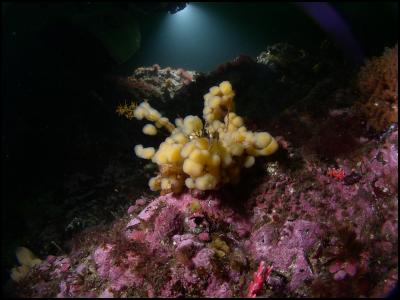
Click for big version
Photo: Mike Page, NIWA – A colonial sea squirt Eudistoma sp. (probably a new species) growing on a hydrozoan
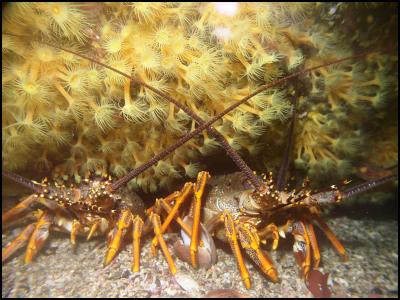
Click for big version
Photo: Sean Handley, NIWA – Crayfish sheltering under zooanthids
Scientists believe they have found new species after two weeks surveying Fiordland’s underwater ‘china shops’. Some of the sites have never been dived before, and another survey is due to start soon.

Click for big version
Photo: Sean Handley, NIWA - Butterfly perch and black coral
They are called ‘china shops’ for a reason ¬– areas of particular biological interest or fragility, some of which are designated as no anchoring zones under management plans implemented by the Fiordland Marine Guardians and the Department of Conservation (DOC). China shops are often sites where protected species such as black or red corals are present in high densities, or where other species are found much closer to the sea surface than usual.
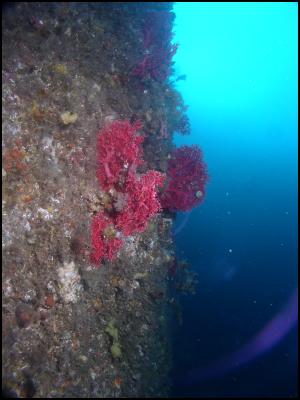
Click for big version
Photo: Mike Page, NIWA – red coral on cliff face
The surveys are a collaboration between DOC and NIWA (the National Institute of Water & Atmospheric Research). They used a ROV (remotely operated vehicle) and a team of scientific divers equipped with underwater cameras.
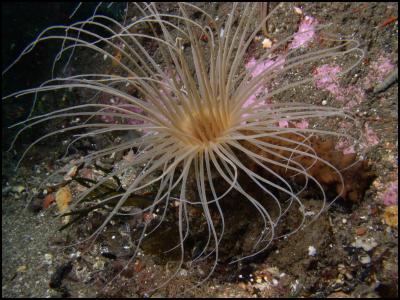
Click for big version
Photo: Trevor Willis, NIWA – Cerianthus anemones extract food passing in tidal currents
“It’s early days yet, but preliminary analyses indicate we have found more than 20 new invertebrates and six new species of algae during the surveys” says project leader Dr Trevor Willis of NIWA. “We have also identified several new areas that are worthy of china shop status and protection – some of these are truly spectacular”. Many of the spots had never been dived before. One, for example, was nicknamed Smiley Face after the numerous large, seven-gilled sharks the divers encountered.
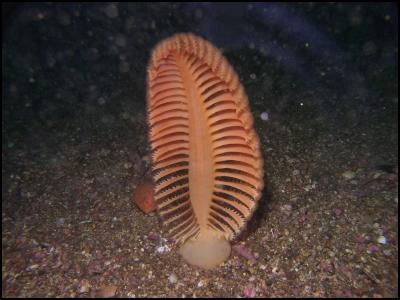
Click for big version
Photo: Sean Handley, NIWA – A sea pen Pteroeides bollonsi at 25 m depth in Preservation Inlet.
Fiordland Marine Guardians chair Malcolm Lawson says “We are very pleased with the results of this project as it will give people more of an appreciation of just what a diverse range of species we have in the Fiordland Marine Area and why it is important to look after it.”
A second survey voyage will take place in early April, when the team will work with ROVs and deep water cameras to study life on the fiord walls at depths greater than 100 metres. “Fiordland is still relatively untouched,” says Dr Willis. “We probably know more about the marine life of Antarctica than this unique area on our own doorstep. I am certain that further surveys will yield new species, and we will be constantly revising the marine biodiversity of Fiordland.”
DOC Marine Ranger, Kath Blakemore, says “It’s been great to collaborate with NIWA and the Fiordland Marine Guardians on this project - their expertise and intimate knowledge of the Fiordland marine ecosystem has meant this research will add great value to our knowledge of the area.”

Click for big version
Photo: Mike Page, NIWA – black coral provides habitat for reef fish
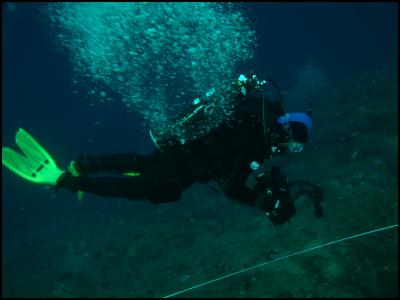
Click for big version
Photo: Sean Handley, NIWA – NIWA diver conducting video transects of reef life
Background
1. Fiordland is home to New Zealand’s largest marine managed area. It sits alongside the country’s largest national park and is a World Heritage Area. The Fiordland Marine Area is 882,000 hectares. (An international rugby field is ~1.008 ha).
2. The region has ten marine reserves, where no fishing or disturbance of any kind is permitted. The dive team also surveyed six of these reserves to determine whether lobster and fish densities have begun to increase since the reserves were implemented in 2005. Results are being analysed by NIWA and will be provided to DOC in June 2009.
3. More background on Fiordland’s unique marine environment: www.fmg.org.nz
ENDS


 Tourism New Zealand: Tourism New Zealand Invites The World To Find Their 100% Pure New Zealand In New Global Campaign
Tourism New Zealand: Tourism New Zealand Invites The World To Find Their 100% Pure New Zealand In New Global Campaign Bill Bennett: Comcom warns 2degrees over satellite marketing
Bill Bennett: Comcom warns 2degrees over satellite marketing Transpower: Major Electricity Development For Western Bay Of Plenty A Step Closer
Transpower: Major Electricity Development For Western Bay Of Plenty A Step Closer Alcohol Beverages Council: Turning The Tide - New Zealanders Unite To Curb Harmful Drinking
Alcohol Beverages Council: Turning The Tide - New Zealanders Unite To Curb Harmful Drinking University of Auckland Business School: Economists Urge Action To Prevent ‘AI Poverty Traps’
University of Auckland Business School: Economists Urge Action To Prevent ‘AI Poverty Traps’ Bill Bennett: Australian warship takes rural fixed wireless broadband offline
Bill Bennett: Australian warship takes rural fixed wireless broadband offline


